Agapanthus praecox
Agapanthus praecox Willd.
Family: Agapanthaceae
Common names: common agapanthus, blue lily (Eng.); bloulelie, agapant (Afr.); isicakathi (Xhosa); ubani (Zulu)
Introduction
I doubt that there is a South African gardener alive that has not come across an agapanthus somewhere! They line our roads, and are in most gardens and parks, from the tall globular-headed ones to the ever-shrinking dwarf cultivars now available at garden centres. Most of the agapanthus that are grown are cultivars or hybrids of Agapanthus praecox.
Description
Description
Agapanthus is a very variable genus, yet they are all broadly similar in appearance, with rhizomatous roots, strap-like leaves and an umbellate inflorescence on a stalk held above the leaves. Botanists have always found it tricky to classify them into distinct species. Frances Leighton revised the genus in 1965, recognizing ten species in total: four evergreen species, viz. A. africanus, A. comptonii, A. praecox and A. walshii and six deciduous species, viz. A. campanulatus, A. caulescens, A. coddii, A. dyeri, A. inapertus and A. nutans. Zonneveld & Duncan (2003), using nuclear DNA content and pollen vitality and colour, as well as morphology, now consider A. comptonii to be identical to A. praecox subsp. minimus; A. walshii to be a subspecies of A. africanus; A. dyeri to be identical to A. inapertus subsp. intermedius; and A. nutans to be identical to A caulescens. As a result there are now only two evergreen species i.e. A. africanus and A. praecox and four deciduous species i.e. A. campanulatus, A. caulescens, A. coddii and A. inapertus, making six species in total.
The evergreen species come from the winter rainfall Western Cape and all-year rainfall Eastern Cape and shed a few of their old outer leaves every year and replace them with new leaves from the apex of the growing shoot. The deciduous species come from the summer rainfall Eastern Cape, KwaZulu-Natal, Swaziland, Free State, Lesotho, Gauteng, Mpumalanga, Limpopo and Mozambique, and grow rapidly in spring with the onset of the rains, and then lose their leaves completely and lie dormant during winter. Deciduous species covered on this website to date include A. coddii, and A. inapertus with its dark blue clone 'Graskop'.
Agapanthus praecox, one of the evergreens, is an extremely variable species consisting of three subspecies: subsp. praecox, subsp. orientalis and subsp. minimus. It can be recognized by its 6-20 leaves per individual plant. These leaves are strap-like and may be leathery or flaccid, narrow or broad, short or long and have blunt or pointed tips. Although this description is very broad, it is relatively easy to tell it apart from the other evergreen species: A. africanus is restricted to Western Cape, mainly from the Cape Peninsula to Paarl and Stellenbosch, and as far eastwards as Swellendam. Its range does not overlap with that of A. praecox. It is small, 250 to 700 mm, flowers in late summer (December to April) and its perianth is thick or fleshy in texture and the leaves are leathery.
Many gardeners and even some authors of publications mistakenly call the agapanthus in cultivation A. africanus. This is almost certainly incorrect. A. africanus is a winter rainfall plant and is difficult in cultivation, needing very well-drained soil, hot, dry summers and wet winters. Practically all the evergreen agapanthus in cultivation in the world, are hybrids or cultivars of A. praecox.
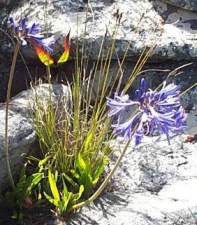
Agapanthus species are easily able to hybridize with each other, particularly when grown in close proximity and as a result, a bewildering array of garden hybrids have arisen. At Kirstenbosch in addition to having many examples of the pure, wild-collected Agapanthus species on display, we have a number of different forms of the species, both of garden origin and wild-collected. Those that we have for A. praecox are shown below.
Distribution and habitat
Distribution description
Agapanthus praecox subsp. praecox occurs in Eastern Cape. It is generally 0.8 to 1 m tall and flowers in mid to late summer (December - February). It is distinguished from the other two subspecies by its longer perianth segments (50 mm or longer) and fewer leaves (10-11 per plant) which are leathery and suberect (spreading rather than arching). Flowers are open-faced and medium blue.

Agapanthus praecox subsp. orientalis (F.M.Leight.) F.M. Leight. occurs in Eastern Cape and southern KwaZulu-Natal and is also generally 0.8 to 1 m tall and flowers in mid to late summer (December - February). It is distinguished from subsp. praecox by its shorter perianth segments (less than 50 mm), and it has more leaves (up to 20 per plant) which are not leathery and have an arching habit. It differs from subsp. minimus by having a more dense inflorescence, the whole plant is larger and it forms thick clumps. Flowers are open-faced, pale to medium blue or pure white.
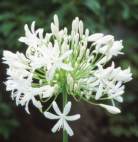
Agapanthus praecox subsp. minimus (Lindl.) F.M.Leight. occurs in the southeastern Western Cape and Eastern Cape, is smaller than the other two, only 300 to 600 mm tall, and starts flowering earlier, from early to late summer (November to March). It differs from the other two subspecies in being a smaller plant, with fewer leaves per plant (up to 10) and there are fewer flowers in the inflorescence. It has shorter perianth segments than subsp. praecox (less than 50mm) and it does not form as dense clumps as subsp. orientalis. Flowers are open-faced, pale to dark blue or occasionally greyish white or white.
Derivation of name and historical aspects
History
The genus Agapanthus was established by L'Heritier in 1788. It used to be included in the Liliaceae (lily family), was then moved to the Amaryllidaceae (amaryllis and daffodil family), moved again into the Alliaceae (onion family) then back to Amaryllidaceae and now resides in its own family, the Agapanthaceae. All this taxonomic to-and-fro'ing seems to be about whether its umbellate inflorescence is considered to be of greater taxonomic importance than its superior ovary. It is placed in its own family, a sister family to the Amaryllidaceae, on the strength of its superior ovary, the presence of saponins and the absence of amaryllid alkaloids.
The Agapanthaceae is a monotypic family (consists of only one genus) that is endemic to southern Africa, i.e. Agapanthus occurs naturally nowhere else on Earth. The six variable species are widespread in all the provinces of South Africa except for the Northern Cape, and in Lesotho, Swaziland and Mozambique, but not in Namibia or Botswana. They occur only in areas where the rainfall is more than 500 mm (20 inches) per annum, from sea level to 2 000 m (7000 ft), with a distribution range that extends from the Cape Peninsula in the southwest, along the southern and eastern coast of southern Africa then inland and northwards into the mountainous regions south of the Limpopo River.
The name Agapanthus is derived from the Greek agapé, love, and anthos, flower. There is no clear reason for this derivation although it could be interpreted as 'lovely flower' or 'flower of love'. Agapeo means 'to be contented with' which is a possible derivation, i.e. 'flower with which I am well pleased'. The specific name praecox means early, premature, unseasonable or precocious in Latin, and was possibly given because compared to the other species it is an early flowerer; minimus means smallest, which it is; and orientalis of the east, which is most likely a case of mistaken origin. Quite often in those days, the ships carrying the new plant material back to Europe came from the East, via the Cape, and some of the botanists assumed that all the plants on board came from the East.
Agapanthus has attracted a few common names over the years. In its first publication in Europe in 1679 it was called the African hyacinth. Linnaeus called it the African lily, and nowadays in Europe and America it is still known as the African lily, but also rather inappropriately as lily of the Nile. In South Africa they are commonly referred to as agapanthus.
Uses
Use
Agapanthus is considered to be both a magical and a medicinal plant, and the plant of fertility and pregnancy. Xhosa women use the roots to make antenatal medicine, and they make a necklace using the roots that they wear as a charm to bring healthy, strong babies. The Zulu use agapanthus to treat heart disease, paralysis, coughs, colds, chest pains and tightness. It is also used with other plants in various medicines taken during pregnancy to ensure healthy children, or to augment or induce labour. It is also used as a love charm and by people afraid of thunderstorms, and to ward off thunder. Margaret Roberts advises hikers to put leaves in their shoes to soothe the feet, and to wrap weary feet in the leaves for half an hour. The long, strap-like leaves also make an excellent bandage to hold a dressing or poultice in place, and winding leaves around the wrists are said to help bring a fever down.
Agapanthus contains several saponins and sapogenins that generally have anti-inflammatory (reduce swelling and inflammation), anti-oedema (oedema = swelling due to accumulation of fluid), antitussive (relieve or suppress coughing) and immunoregulatory (have influence on the immune system) properties. Although the precise activity of agapanthus compounds is not known, preliminary tests have shown uterotonic activity (increases the tone of uterine muscles).
Agapanthus is suspected of causing haemolytic poisoning in humans, and the sap causes severe ulceration of the mouth.
Growing Agapanthus praecox
Grow
Agapanthus praecox is easy to grow and it does well even in the poorest of soils, but it must receive some water in summer. To perform at its best, give it rich, well-drained soil with ample compost (decayed organic matter) and plenty of water in spring and summer. As with most plants they benefit most from regular (e.g. weekly) deep drenching as opposed to frequent superficial waterings. It prefers full sun, and some cultivars will flower in semi-shade. All the evergreen agapanthus are best lifted and divided every four years or so to ensure flowering. A. praecox will tolerate light frost, but is hardy only in the milder parts of the Northern Hemisphere, like the southwest of England and in the Mediterranean. In areas with extreme winter temperatures they are best grown in the cool greenhouse, or in containers that can be taken into a greenhouse during winter.
Agapanthus praecox is ideal for mass displays, the larger species and cultivars are wonderful as a backdrop to the herbaceous border, whereas the smaller ones are excellent in the front of the border, or as an edging plant or in rockeries. They are a good companion for winter growing plants like Chasmanthe floribunda. All of them make good pot plants. A. praecox is also an excellent plant to use to stabilize a bank and to prevent erosion, and in difficult seaside gardens they stand up to the wind. A. praecox is an excellent cutflower, either whole heads, or individual flowers in small arrangements or wired and used in bouquets and posies.
Propagation is by seed or division. Because agapanthus plants hybridize freely with each other, and are all in flower at the same time, you can be sure that there will be hybrids from seed harvested in the Kirstenbosch Garden. To get pure seed of any Agapanthus species it would have to be habitat collected or pollinated under strictly controlled conditions. Even then, there is always a degree of variation in the offspring. If you are after a particular cultivar, division is still the most reliable way of making sure that the material being propagated will be exactly true to type.
Seed can be sown fresh, in late summer - autumn, but in cold climates it can be kept refrigerated (not frozen) and sown in spring. It must be kept in the refrigerator or it will perish. Seed should be sown in deep (10 cm) trays, in a mixture of equal parts river sand and fine compost, and kept semi-shaded and moist. Seed germinates readily within six to eight weeks. The seed should be sown thinly as the seedlings will stay in the tray for their first year. Seedlings should be potted up into individual containers during their second year and can be planted into the garden or permanent pots in their third year. Flowering can be expected from their third or fourth year.
Clumps are best lifted and divided just after the end of their flowering period in early March (late summer - autumn). Unlike the deciduous species, which should be left alone for up to 6 years and often don't flower the first year after being divided, the evergreens are best lifted every four years and usually flower best in their first season after dividing. You need your health and strength to lift and divide large agapanthus clumps - what works well is to place two garden forks back to back in the centre of the clump and prize them apart. Or the clump can be chopped up with a spade. Reduce the length of the foliage by one half and reduce the roots by two-thirds. Replant immediately and water thoroughly.
Agapanthus praecox is generally pest- and disease-free. Foliage may be attacked by red spider mites, thrips, and mealy bug but need only be sprayed if infestation is severe. Agapanthus are famous for harbouring snails, although the snails do not seem to cause any damage to the plants themselves. The best way to combat them is to remove them by hand or to keep ducks. Botrytis, visible as brownish lesions, may attack the flowers preventing them from opening. There is no cure, it can only be prevented by spraying before and after the buds break open. The foliage may be attacked by the fungus Macrophoma agapanthii causing die-back of the leaves, and in severe cases can be combatted with a fungicide like mancozeb or captab as a full cover spray.
Species
Agapanthus praecox 'Dwarf White'
leaves approx. 165 mm, flower stalks up to 500 mm, white flowers in early summer, very floriferous, multiplies well, ideal for rockeries.
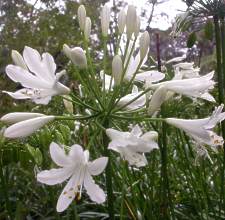
Agapanthus praecox 'Medium White'
leaves approx. 330 mm, flower stalks up to 800 mm, compact, white flowerheads in summer.
Agapanthus praecox 'Miniature White'
narrow leaves approx. 300 mm high, flower stalks up to 650 mm tall.
Agapanthus praecox subsp. minimus 'Adelaide'
leaves approx. 500 mm, flower stalks up to 800 mm tall, bright blue flowers in summer, very floriferous all summer, full sun or partial shade, good ground cover. Read more about this plant.
Agapanthus praecox subsp. minimus 'Storms River'
leaves approx. 600 mm, flower stalks up to 800 mm, unusual very pale blue to greyish white, large flowerheads in summer, full sun or light shade.
Agapanthus praecox subsp. orientalis 'Mt Thomas'
leaves approx. 800 mm, flower stalks up to 1 200 mm, bright blue, compact flowerheads in summer, grey foliage.
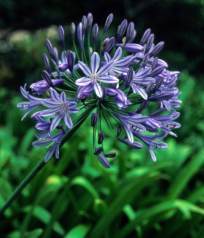
Agapanthus praecox subsp. orientalis 'Weaver'
leaves approx. 800 mm, flower stalks up to 1 000 mm, large, blue flowerheads in summer, floriferous, sun or semi-shade.
Agapanthus praecox subsp. praecox 'Azure'
leaves approx. 800 mm, flower stalks up to 1 000 mm, dark blue flowerheads in midsummer, broad, evergreen leaves, prefers partial shade.
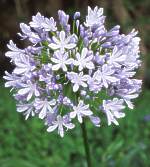
Agapanthus praecox subsp. praecox 'Floribunda'
leaves approx. 800 mm, flower stalks up to 1 000 mm, attractive leaves, large heads of blue flowers in summer, full sun or semi-shade.
References
- Duncan, G. 1998. Grow Agapanthus. A guide to the species, cultivation and propagation of the genus Agapanthus. National Botanical Institute, Cape Town.
- Du Plessis, N. & Duncan, G. 1989. Bulbous plants of southern Africa. A guide to their cultivation and propagation. Tafelberg, Cape Town.
- Hutchings, A. 1996. Zulu medicinal plants, an inventory. University of Natal Press, Pietermaritzburg.
- Jackson, W.P.U. 1990. Origins and meanings of names of South African plant genera. University of Cape Town Printing Dept., Cape Town.
- Leighton, F.M. 1965. The genus Agapanthus L'Heritier. Journal of South African Botany, suppl. vol. no. 4. National Botanic Gardens, Cape Town.
- Leistner, O.A. (ed.) 2000. Seed plants of southern Africa: families and genera. Strelitzia 10. National Botanical Institute, Pretoria.
- Roberts, M. 1990. Indigenous healing plants. Southern Book Publishers, Halfway House, Gauteng, South Africa.
- Van Wyk, B.E., Van Oudtshoorn, B. & Gericke, N. 1997. Medicinal plants of South Africa. Briza Publications, Pretoria.
- Zonneveld, B.J.M. & Duncan, G.D. 2003. Taxonomic implications of genome size and pollen colour and vitality for species of Agapanthus L'Heritier (Agapanthaceae). Plant Systematics and Evolution 241: 115-123.
Credits
Alice Notten
Kirstenbosch National Botanical Garden
January 2004
Plant Attributes:
Plant Type: Bulb, Ground Cover
SA Distribution: Eastern Cape, Western Cape
Soil type: Sandy, Clay, Loam
Flowering season: Early Summer, Late Summer
PH:
Flower colour: Blue, White
Aspect: Full Sun, Morning Sun (Semi Shade), Afternoon Sun (Semi Shade)
Gardening skill: Easy
Special Features:
Horticultural zones












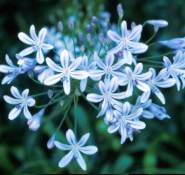
Rate this article
Article well written and informative
Rate this plant
Is this an interesting plant?
Login to add your Comment
Back to topNot registered yet? Click here to register.